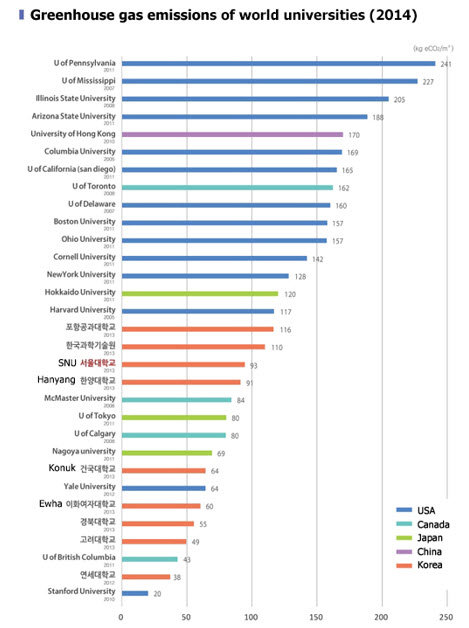
SNU is the biggest energy consuming institution in Seoul
Seoul National University (SNU) has recently decided to adopt micro-grid technology on Gwanak Campus. A micro-grid is an independent and intelligent energy system that maximizes the efficiency of electricity use through big data, Internet of Things (IoT) and Energy Storage System (ESS). A total of 22 businesses and organizations, led by LS Industrial Systems, a Korean corporation that manufactures and supplies electric power equipment, will invest 130 billion won (115 million USD) by 2020 to initiate the micro-grid project.
According to a report by Seoul Metropolitan Government, SNU was marked as the biggest electricity consuming institution in Seoul in both 2012 and 2013. Although SNU's Gwanak Campus is indeed like a small city, consisting of more than two hundred lecture buildings, residential apartments, research institutes and cafeterias, its electricity use (43,137 TOE) surpasses that of other major organizations in Seoul such as Lotte Hotel World (34,889 TOE), Asan Medical Center (32,307 TOE) and Samsung Medical Center (30,872 TOE). Compared to Yonsei University and Korea University, SNU has been estimated to use more than twice as much electricity. Implementing the micro-grid system will allow Gwanak Campus to reduce electricity consumption by 20%.
Generally, a micro-grid operates as a local energy grid that is connected to the traditional grid. This traditional grid is what connects various buildings to a central power source, but areas that have adopted micro-grids are able to disconnect and operate on their own. In terms of a university campus, a micro-grid uses big data to collect information about the temperature and humidity of every building, and then analyzes general energy demands as well as potentially wasted energy. Any leftover energy is stored through the ESS technology for later use, or sent to other buildings that need more energy.
SNU's Gwanak Campus will be the first urban area to embrace micro-grid technology in Korea. So far, only some of the smallest Korean islands have built micro-grids. Gasado Island in South Jeolla Province, which housed the first micro-grid system in Korea in October 2014, generates its own electricity from renewable energy sources. Since the implementation of micro-grid technology, the island has been able to save more than 150 million won (135,000 USD) in fuel and logistics cost.
Micro-grids may become very useful for areas that find it difficult to maintain an adequate level of energy transmission, but university campuses can also make good use of micro-grids as the technology leads to a significant amount of electricity cost reduction. The market size of micro-grids worldwide is projected to reach 40 billion USD in annual revenue by 2020, which is a huge increase compared to about 10 billion USD in 2013. In the U.S., many university campuses including Harvard University, Princeton University and University of California, San Diego have already readily adopted micro-grids.
The cost efficient and environmentally friendly qualities of micro-grid technology give micro-grids much growth potential in the future. Korea is aiming to utilize micro-grid technology in more of the nation's main institutions, with SNU taking the lead.
Written by YOON Jiwon, SNU English Editor, jiwonyoon@snu.ac.kr
Reviewed by Eli Park Sorensen, SNU Professor of Liberal Studies, eps7257@snu.ac.kr

